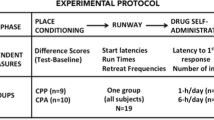Abstract
Two strains of rats — LC2-Hi and LC2-Lo — selected for high and low self-stimulation rates, respectively, were tested for responses to opiates and to naloxone using conditioned place preference paradigm. In the two experiments which used opiates as UCS, conditioning was carried out in the non-preferred compartment while in the experiment which used naloxone, conditioning was performed in the preferred compartment. The preference changes were determined on the basis of times spent in the compartments before and after conditioning with drugs. LC2-Hi rats showed positive changes in the preference to the initially non-preferred side when morphine or heroin (5 mg/kg and 1 mg/kg, respectively) were used; no such effect was observed with LC2-Lo rats. Both lines exhibited aversive reactions to naloxone by diminishing the time spent in the environment paired with this drug, but again the response of LC2-Hi animals was significantly larger than the response of LC2-Lo rats. Chronic intake of a sweet solution (3 mM saccharin for 4 weeks) tended to amplify the aversive reaction to naloxone in both lines. It may be inferred from the present findings that there exists a common genetic factor, as revealed by the conditioned place preference paradigm, underlying positive reinforcing properties of opiates and aversive effects of naloxone.
Access this article
We’re sorry, something doesn't seem to be working properly.
Please try refreshing the page. If that doesn't work, please contact support so we can address the problem.
Similar content being viewed by others
References
Ben-Shakhar G (1985) Standardization within individuals: A simple method to neutralize individual differences in skin conductance. Psychophysiology 22:292–299
Bergmann F, Lieblich I, Cohen E, Ganchrow J (1985) Influence of intake of sweet solutions on pain responses and morphine tolerance in randomly bred rats. Behav Neural Biol 44:347–353
Blander A, Hunt T, Blair R, Amit Z (1984) Conditioned place preference: An evaluation of morphine's positive reinforcing properties. Psychopharmacology 84:124–127
Broekkamp CL, Phillips AG, Cools AR (1979) Facilitation of self-stimulation behavior following intracerebral microinjection of opioids into the ventral tegmental area. Pharmacol Biochem Behav 11:560–562
Cohen E, Lieblich I, Ganchrow J (1982) Saccharin preference in prepubertal male and female rats: Relationship to self-stimulation. Behav Neurol Biol 36:88–93
Cohen E, Lieblich I, Bergmann F (1984) Effects of chronically elevated intake of different concentrations of saccharin on morphine tolerance in genetically selected rats. Physiol Behav 32:1041–1043
Cooper SJ (1984) Sweetness reward and analgesia. TIPS 5:322–323
Ganchrow JR, Lieblich I, Cohen E (1981) Consumatory responses to taste stimuli in rats selected for high and low rates of self-stimulation. Physiol Behav 27:971–976
Lieblich I, Cohen E, Beiles A (1978) Selection for high and for low rates of self-stimulation in rats. Physiol Behav 21:843–849
Lieblich I, Cohen E, Marom BZ, Dymshitz J (1980) A genetically mediated relationship between the readiness to self-stimulate lateral hypothalamus and the intensity of septal and ventromedial hypothalamic rage syndromes. Brain Res 185:253–263
Moreau JL, Cohen E, Lieblich I (1984) Ventral tegmental self-stimulation, sensory reactivity and pain reduction in rats selected for high and low rates of lateral hypothalamic self-stimulation. Physiol Behav 33:825–830
Mucha RF, Iversen SD (1984) Reinforcing properties of morphine and naloxone revealed by conditioned place preference: a procedural examination. Psychopharmacology 82:241–247
Spyraki C, Fibiger HC, Phillips AG (1983) Attenuation of heroin reward in rats by disruption of the mesolimbic dopamine system. Psychopharmacology 79:278–283
Valenstein ES, Kakolewski JW, Cox VC (1967) Sex differences in taste preference for glucose and saccharin solutions. Science 156:942–943
Valenstein ES, Lieblich I, Dinar R, Cohen E, Bachus S (1982) Relation between eating evoked by lateral hypothalamic stimulation and tail pinch in different rat strains. Behav Neural Biol 34:271–282
Author information
Authors and Affiliations
Additional information
This study was supported by the Frenkel Fund, the Department of Psychology, The Hebrew University of Jerusalem, and by the Fund for Basic Research administered by the Israel Academy of Sciences and Humanities.
It is regretfully noted that Prof. I. Lieblich passed away prior to the final revision of the manuscript.
Rights and permissions
About this article
Cite this article
Dymshitz, J., Lieblich, I. Opiate reinforcement and naloxone aversion, as revealed by place preference paradigm, in two strains of rats. Psychopharmacology 92, 473–477 (1987). https://doi.org/10.1007/BF00176481
Received:
Revised:
Issue Date:
DOI: https://doi.org/10.1007/BF00176481




